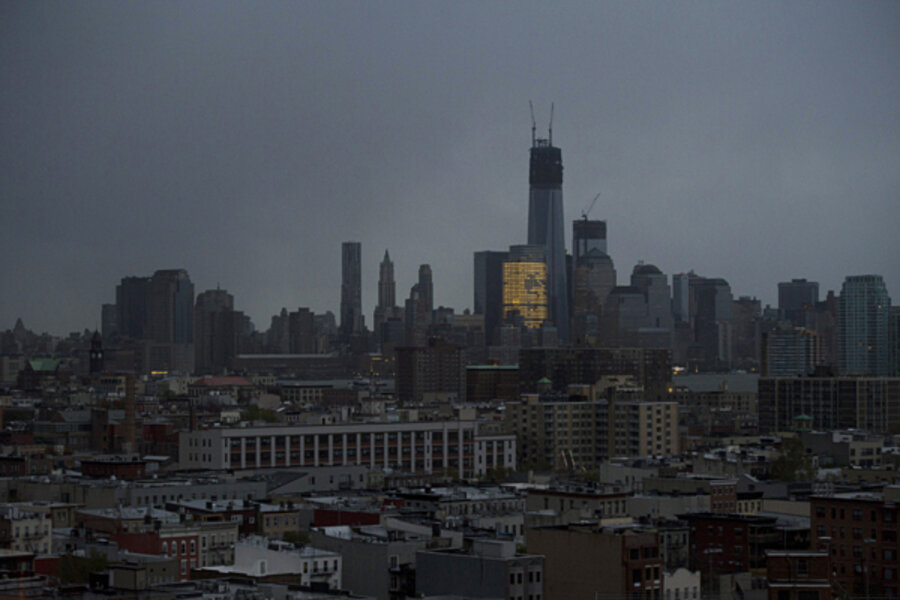Climate change threatens nation's energy, DOE report warns
Loading...
A nuclear plant shuts down when high temperatures overheat its reactor. A drought-stricken city bans the use of its increasingly scarce water in hydraulic fracturing. More than 8 million customers lose power when winds topple utility poles and a storm surge floods transformers and underground power lines.
Extreme weather and a changing climate are disrupting the ways we generate, distribute, and consume energy, according to a report released Thursday by the US Department of Energy (DOE).
That's not exactly breaking news to anyone who's ever suffered through a blackout in the midst of a storm, but the government report details the extent of energy's vulnerability to weather, from the light bulbs in your kitchen all the way to rigs drilling for oil in the Gulf of Mexico. It's part of a growing recognition among local, state, and federal officials for a need to plan for and adapt to the planet's changing climate.
"When you think about any individual circumstance, it's not a surprise," Jonathan Pershing, who led the development of the DOE report, said in a phone interview. "What was a surprise was putting it all together and seeing how large and pervasive the damage is."
Higher air and water temperatures, scarcer water resources, and more intense and frequent storms routinely disrupt modern energy infrastructure, according to the report. That includes high-profile failures like the outages in the wake of superstorm Sandy, but the report also points to less-visible, more pervasive ways in which energy is vulnerable to extreme weather and climate change.
Last summer's drought, for example, lowered river water levels, disrupting the shipment of petroleum and coal delivered by barges. In 2010, unusually low precipitation in the Columbia River basin deprived hydroelectric dams of water flow needed to meet electricity demand. In the Arctic, thawing permafrost and melting ice can damage oil pipelines and restrict access to resources.
"Climate change is not the only risk, but it piles on a couple of different problems going in the same direction," James Newcomb, program director at the Rocky Mountain Institute, a nonprofit focused on resource efficiency, said in a phone interview. "Solar storms, cyberattacks, extreme weather all pose the risk of cascading blackouts that can have extraordinary consequences for the economy."
President Obama highlighted these threats in a speech on climate change at Georgetown University last month. With Congress unable to pass a broad climate policy, Mr. Obama directed the Environmental Protection Agency to impose carbon limits on both new and existing coal power plants. He called on other federal agencies to take a hard look at their own contribution and vulnerability to a volatile climate.
State and local governments are also looking at ways they can mitigate extreme weather threats to infrastructure. Motivated largely by the devastation from superstorm Sandy, New York City Mayor Michael Bloomberg unveiled last month a $20 billion plan to protect New Yorkers from storm surges. Four counties in southern Florida have collaborated on a plan to manage the regions ecosystems and slow the flow of seawater into freshwater.
"[The DOE report} is another indication of the recognition among key actors that climate change is a significant risk to what they’re responsible for taking care of," Jennifer Morgan, director of the climate and energy program at the World Resources Institute, said in a phone interview. She added that the evidence of threats to the traditional, carbon-based energy system should play a significant role in the broader debate over America's energy future.
The challenges aren't without solutions. The DOE calls for improved efficiency across the grid and the strengthening of transmission lines, power plants, oil and gas refineries, and other energy equipment. Greater coordination is needed between governments, industry, and civilians to identify risks and vulnerabilities, and protect against them, according to the report.
"This is not an issue that can’t be addressed. It is going to be bad, but we can do something about this," said Mr. Pershing, who is deputy assistant secretary for climate change policy and technology at the Department of Energy. "It will cost us tens of billions of dollars to fix the problems, or at least address them, but if we don't, it will cost us hundreds of billions in damage."






